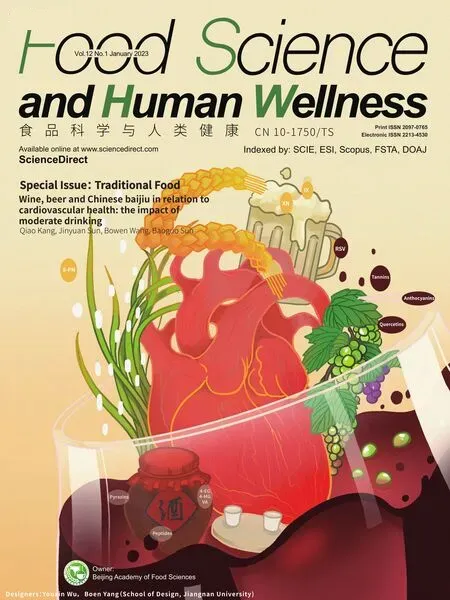Effect of inoculating mixed starter cultures of Lactobacillus and Staphylococcus on bacterial communities and volatile f lavor in fermented sausages
2023-01-22YuxinLiZhixingCoZhihuiYuYingchunZhuKileZho
Yuxin Li, Zhixing Co, Zhihui Yu, Yingchun Zhu,*, Kile Zho
a College of Food Science and Engineering, Shanxi Agricultural University, Taigu 030801, China
b College of Food Science and Technology, Hebei Agricultural University, Baoding 071001, China
Keywords:Starter Fermented sausages High-throughput sequencing Volatile f lavor compounds Principal component analysis
A B S T R A C T The objective of this study was to explore the effects of the inoculation of mixed starter cultures of Lactobacillus and Staphylococcus (labeled L-S) on microbial community and f lavor in fermented sausages during the ripening process. Culture-dependent (colony count) and culture-independent (high-throughput sequencing) methods were employed to evaluate bacterial communities. Volatile compounds were identif ied by gas chromatography–mass spectrometry, and the results were analyzed by principal component analysis(PCA). The identif ied bacteria with high relative abundance included Lactobacillus and Pediococcus, and the relative abundances of Leuconostoc and Weissella in fermented sausages were remarkably decreased at the end of the ripening process. At the end of ripening, 2-nonenal, tetradecanal, ethylstearate and terpinyl acetate played substantial roles in the f lavor development of the L-S fermented sausages. Sensory evaluation showed a high score in the L-S fermented sausages. Sausages can be inoculated with L-S starter culture to improve the safety and f lavor of meat products.
1. Introduction
The most commonly used ingredients in the production of fermented sausages include lean pork, pork back fat, salts, and spices [1]. These ingredients are stuffed into natural pig casings and then fermented and ripened under controlled conditions.The characteristics of the f inal sausages depend on the metabolic activities of bacterial strains in the ripening process. Bacterial community compositions are affected by the inoculated starter. The use of starter cultures improves the quality and safety of traditional meat products. Different physical and chemical conditions, such as pH, temperature, and nutrient, also affect the physicochemical and sensory qualities of sausages.
Culture-dependent method is commonly used to determine the dominant strains in meat products. The microorganisms used in traditional isolation methods only represent less than 1% of the environmental microorganisms [2]. High-throughput sequencing has been widely applied to investigate microbiota since the development of bioinformatic analysis methods [3]. This method combines genome sequencing and bioinformatics analysis to provide bacterial information without the need for the culture process; thus, this method is a simple,fast, and convenient means for strain detection. Wang et al. [4]found thatLactobacillus,Weissella, andStaphylococcuswere the dominant bacteria in Chinese fermented sausages by using high-throughput sequence technology. Zang et al. [5] used highthroughput sequencing based on 16S rRNA gene amplification to study the differences before and after fermentation and found thatLactococcus,Leuconostoc,Enterococcus,Vibrio,Fusicolla, andTorulasporawere inhibited by inoculation treatment.
Flavor development is also influenced by bacterial community compositions during the ripening of fermented sausages. Lipolytic and proteolytic activities contribute to flavor formation. Protease and lipase are produced by strains, such asLactobacillusandStaphylococcus,during the fermentation and ripening process [6,7].Lipolysis catalyzed by lipases leads to the release of flavor compounds, such as aldehydes and alcohols. The free amino acids generated from proteolysis are the precursors of flavor compounds and directly or indirectly responsible for flavor formation. Protease and lipase are produced by strains during the fermentation and ripening processes. Metatranscriptome analysis further showed thatLactobacillusexpresses multiple key enzymes related to flavor components, such as acetate kinase, pyruvate dehydrogenase,asparagine synthase, and aspartate aminotransferase [8]. These studies provide the theoretical basis of flavor development.
In a previous study, we screened out 12 strains from sour porridges, sausages, and bacon products in China. The degradation of nitrite and biogenic amines (BAs), the activities of nitrite-reducing enzymes, and the detection of genes involved in the BAs were assessed. The results showed that the degradation rates of nitrite and BAs inPediococcus pentosaceusM SZ1 2,P. pentosaceusM GC 2,Lactobacillus plantarumM SZ2 2, andStaphylococcus xylosusY CC 3 were high [9]. The compounding ratio of starters that could decrease BAs and nitrite remarkably in a nutritious broth system was M SZ1 2:M GC 2:M SZ2 2:Y CC 3 = 1:1:1:6. However, the study pointed out that much of the literature focused on physicochemical properties and that the effects of starters on safety and flavor are unclear. In the present study, commercial SBM-52 starter cultures provided the necessary reference for mixedLactobacillusandStaphylococcus(L-S) starter cultures. The microbial succession and microbial diversity of L-S were analyzed. Furthermore, the potential correlations between the core bacteria and function were explored. The changes in the flavor compounds of L-S and SBM-52 fermented sausages from the start to the end of ripening were revealed. The major compounds that influence flavor changes were explored. The effect of flavor at the end of ripening was assessed in the L-S fermented sausages. This study provides a theoretical basis for developing a new safe starter for fermented products.
2. Materials and methods
2.1 Starter culture and bacterial strain
P. pentosaceusM SZ1 2,P. pentosaceusM GC 2,L. plantarumM SZ2 2, andS. xylosusY CC 3 were isolated from porridges, sausages,and bacon products, which are traditional Chinese fermented products. The strains were identified by 16S rDNA sequencing.At the exponential growth phase, the strains were collected by centrifugation at 10 000 ×gfor 10 min at 4 °C and stored in glycerin in a refrigerator (DW-86L416G, Qingdao Haier Biomedical Co., Ltd.,Shandong, China) at −80 °C. The strains stored at the School of Food Science and Engineering, Shanxi Agricultural University. Strains were obtained by centrifugation (5804R, Eppendorf Technology Co.,Germany) at 8 000 ×gfor 10 min and then stored at 4 °C for use.
2.2 Preparation of fermented sausages
Fresh lean pork and back fat were obtained from Shuanghui Food Co., Ltd. in Taigu, where pigs that ten-month-old female Landrace pigs were slaughtered followed to theRegulations for theAdministration of Pig Slaughtering of China. The fermented sausages were prepared with 70% lean pork meat and 30% pork back fat. The lean pork meat was pickled with sodium nitrite (0.015%), salt (2.8%),sodium tripolyphosphate (0.3%), and ascorbate (0.05%) at 4 °C for 24 h and mixed with fat with a variety of spices (five-spice powder(0.6%), pepper (0.1%), monosodium glutamate (0.6%), sugar (5%)).The meat mixture was divided into two equal portions (40 fermented sausages per group): one portion was inoculated with the mixed L-S starter culture (M SZ1 2:M GC 2:M SZ2 2:Y CC 3 = 1:1:1:6, L-S group), and the other portion was inoculated with the commercial SBM-52 starter, which includedS. xylosus,Staphylococcus carnosus,P. pentosaceus, andPediococcus acidilactici(Danisco Technology Co., Italy). According to the instructions of the commercial starter(SBM-52), the added amount of SBM-52 starter was 107CFU/g, so the amount of L-S was also 107CFU/g. According to the proportion of M SZ1 2:M GC 2:M SZ2 2:Y CC 3 = 1:1:1:6, the amount added was M SZ1 2:M GC 2:M SZ2 2:Y CC 3 = 1.11 × 106: 1.11 × 106:1.11 × 106:6.66 × 106CFU/g.
The fermented sausages with 40 mm diameters were placed in an incubator chamber (LRHS-150, Yuejin Medical Equipment Factory, Shanghai, China) at a temperature of 30 °C and a relative humidity of 90% until pH < 5.1 for fementation. Then the temperature was dropped to 15 °C and relative humidity was reduced to 65%gradually until water activity (Aw) < 0.82 during the ripening process.It took 13 days for ripening (0-13 days). In the subsequent experiment, six fermented sausages on day 0, 1, 4, 7, 10, and 13 of the ripening process were selected from each treatment for analysis.Two fermented sausages were removed from each treatment for the detection of the sensory evaluation at the end of the ripening stage.The rest sausages were used to determine the other indicators. The counts ofLactobacillus,Lactococcus lactis, andStaphylococcuswere detected on day 0, 1, 4, 7, 10, and 13. L-S and SBM-52 sausage samples on day 0 (L-S_0 and SBM-52_0) and 13 (L-S_13 and SBM-52_13), and CK samples (meat mixture not vaccinated with starter) were stored at −80 °C until high-throughput sequencing analysis. The samples (L-S_0, SBM-52_0, L-S_13 and SBM-52_13)were analyzed for volatile compounds.
2.3 Bacterial community analysis
2.3.1 Bacterial counts by culture-dependent method
Samples (10 g) obtained from the center of sausages were cut with a sterile scalpel and added with 90 mL of normal saline (0.9% NaCl).The samples were shaken with an oscillator (HY-2, Guohua Electric Co., Jiangsu, China) and cultured for 30 min. Ten-fold dilution series were prepared.LactobacillusandL. lactiscounts were determined usingLactobacillusselection agar (Qingdao Haibo Biotechnology Co., Shandong, China) and M17 agar (Qingdao Haibo Biotechnology Co., Shandong, China), respectively, after incubation at 37 °C for 48 h.Staphylococcuscounts were determined using mannitol salt agar(MSA, Qingdao Haibo Biotechnology Co., Shandong, China) after incubation at 30 °C for 48 h.
2.3.2 High-throughput sequencing
The samples stored at −80 °C were sent to Shenggong Biological Engineering Co. (Shanghai, China) for microbial community analysis. Total DNA was extracted by using E.Z.N.ATM Mag-Bind Soil DNA Kit (Omega, USA). The extracts were quantified using the Qubit2.0 DNA Kit (Life, USA). The V3 and V4 regions of bacterial 16S rDNA genes were amplified by using the primers 341F (5′-ATGCGTAGCCGACCTGAGA-3′) and 805R(5′-CGTCAGACTTTCGTCCATTGC-3′). Each reaction mixture contained 15 μL 2 ×TaqMaster Mix, 1 μLBar-PCR primerF(10 μmol/L), 1 μL Primer R (10 μmol/L), 2 μLGenomic DNA(10 ng/μL), add to 30 μL with ddH2O. The first PCR programs were as follows: preheating at 94 °C for 3 min, 5 cycles of denaturing(94 °C, 30 s), annealing (45 °C , 20 s), extension (65 °C, 30 s), 20 cycles of denaturing (94 °C, 20 s), annealing (55 °C , 20 s), extension(72 °C, 30 s) and a final extension at 72 °C for 5 min. The second PCR programs were as follows: 5 cycles of extension (95 °C, 30 s,95 °C, 15 s, 55 °C, 15 s, 72 °C, 30 s, 72 °C, 5 min). All PCR products were run on agarose gel electrophoresis. These products were purified with AMPure XP beads and created the library using universal Illumina adaptor and index. Then the DNA concentration of each PCR product was determined using a Qubit®2.0 Green double-stranded DNA assay. Sequencing was performed by using the Illumina MiSeq system (Illumina MiSeq, USA). The databases that used in this study were as follows: NCBI 16S database (http://ncbi.nlm.nih.gov/) and GenBank functional annotation analyses database (http://fungene.cme.msu.edu/).
2.3.3 Analysis of volatile compounds
The analysis of volatile compounds was performed according to the methods of Wen et al. [10] with slight modifications. Minced sausages (4.0 g) with 0.3 mm diameters were blended with 5 mL of sodium chloride solution (20% NaCl). The samples were placed in a constant-temperature (90 °C) water bath (DZKW-D-2, Sequoia Experimental Equipment Factory, Tianjin, China) for 15 min.Volatile compounds were extracted by solid-phase microextraction and analyzed using a gas chromatography (GC) system (Trace 1300,Thermo Fisher Scientific, Waltham, US) with a mass spectrometer(Trace ISQ, Thermo Fisher Scientific, Waltham, US). Identification was achieved by comparing the mass spectral data of the samples using Certificate of Advanced Studies digital libraries (http://www.ichemistry.cn/).
2.3.4 Sensory evaluation
The L-S and SBM-52 fermented sausages were assessed by 10 experienced members (5 men, 5 women, aged 20–50) using a 9-point hedonic scale at the end of the ripening stage at 7:00 pm-8:00 pm.Evaluation was carried out in a sensory laboratory with individual booths under fluorescent lighting similar to daylight. According to the methods of Pavli et al. [1] with slight modifications, the samples were cut into slices with 5 mm thicknesses. The overall conception of appearance (gloss and redness), odor (aroma and acidity), texture(integrity of casing, cohesion, and elasticity), and taste (acid and aftertaste) was scored. The total assessment scores of the samples were defined. A non-structured evaluation sheet with a 9-point hedonic scale from 0 (low) to 9 (high) was used. The scores less than 5.4 were considered unqualified.
2.4 Statistical analysis
Three batches of fermented sausages were produced independently, and for each batch, the indices of all samples were measured three times. A completely randomized design included treatment groups (L-S, and SBM-52) and storage time (0, 1, 4, 7,10, and 13 days) and three replications. The results are expressed as mean ± standard error.Lactobacillus,L. lactis, andStaphylococcuscounts were analysed basis using the general linear model procedure in the Statistix 8.1 software package (St. Paul, MN) with the detected significant differences (P< 0.05) for multiple mean by Tukey honest significant difference, and the figures were drawn using Origin 9.0.Operational taxonomic units (OTUs) of high-throughput sequencing were clustered with 97% similarity using Usearch [11]. Alpha diversity was calculated by using Mothur version 1.30.1 [12]. Beta diversity analyses were performed using QIIME version 1.7.0. The distances of the samples were determined based on phylogenetic tree and visualized via principal coordinate analysis. The functional prediction of bacterial community based on OTUs was analyzed using the PICRUSt software. Heml 1.0 was used to perrform thermography and cluster analysis. In Simca 14.1, PCA-X model which through quadratic fitting was used to principal component analysis (PCA) for the analysis of volatile compounds. Origin 9.0.software was used to calculate the average value for each sensory trait and drawing the radar figure. ChemSketch 12.0 was used to draw 3D molecular structures.
3. Results
3.1 Bacterial community analysis
The variations in bacterial communities between the two fermented sausages during the ripening process are shown in Fig. 1.As shown in Fig. 1A, theL. lactiscounts of the SBM-52 and L-Sinoculated groups at day 0of theripening process were 8.07 and 8.16 lg (CFU/g). TheL. lactiscounts were 7.99, 7.61, and 7.61 lg (CFU/g)at days 7, 10, and 13 ofthe ripening process in SBM-52 sausages. TheL. lactiscounts declined in L-S sausages during the ripening process and reached 7.64 lg (CFU/g) at day 13.
TheLactobacilluscounts of the SBM-52-inoculated group followed an upward and then a downward trend and reached the highest level of 7.71 lg (CFU/g) at day 1 of the ripening process(Fig. 1B). A significant downward trend inLactobacilluscounts was observed in the L-S-inoculated group over time (P< 0.05).TheLactobacilluscounts in the SBM-52-inoculated sausages were markedly lower than those in the L-S samples at the end of the ripening process probably because of the spontaneous bacterial growth coming from the starter.
TheStaphylococcuscounts showed a downward trend. TheStaphylococcuscounts were significantly higher (P< 0.05) in the SBM-52 samples compared with in the L-S samples at day 0 of the ripening process. This result showed that the SBM-52 starter had a high proportion ofPediococcus(S. xylosusandS. aureus). No significant changes (P> 0.05) were observed in theStaphylococcuscounts between the SBM-52 (4.62 lg (CFU/g)) and L-S-inoculated samples (4.53 lg (CFU/g)) at day 13.
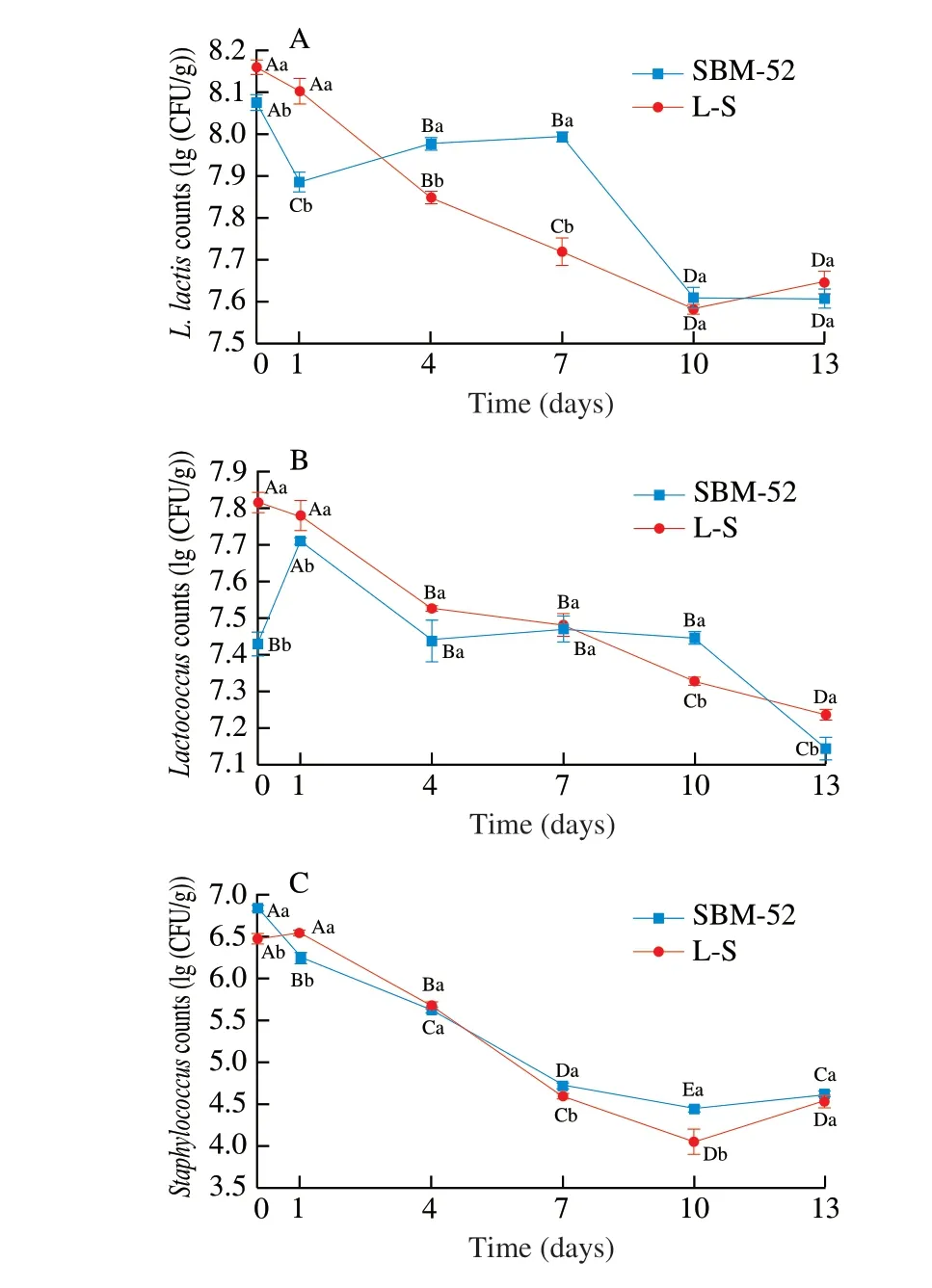
Fig. 1 Effect of starters on bacterial communities during the ripening process. Different lowercase letters indicate significant differences (P < 0.05)between SBM-52 group and L-S group for same ripening times. Different uppercase letters indicate significant differences (P < 0.05) treated with the same starter for different ripening times. Each data point is the mean with the standard deviation (bar) of three replications.
The inoculation of SBM-52 and L-S caused lowerLactobacillus,L. lactis, andStaphylococcuscounts at day 13 than at day 0, and the L-S-inoculated group had higherLactobacilluscounts than the SBM-52-inoculated group.
3.2 Bacterial diversity analyses
3.2.1 Bacterial alpha diversity analyses
A total of 357 235 high-quality sequence reads of 16S rRNA genes were obtained from five samples. The reads had an average sequence length of 429 bp. OTUs with 97% similarity per sample were clustered. The alpha diversity indexes of the samples are shown in Table 1 to assess the diversity and richness of bacterial communities. The coverage indexes of all the samples were 1.00,which indicate the high credibility of the result. Chao and Ace indexes were used to calculate the number of bacterial species,and Shannon and Simpson diversity indexes were used to estimate bacterial diversity. No significant differences were found among the Chao and Ace indexes of L-S_0, L-S_13, SBM-52_0, and SBM-52_13. The Shannon index value of L-S_0 (1.17) was higher than that of L-S_13 (0.93), whereas the Simpson index value of L-S_0 (0.49)was lower than that of L-S_13 (0.64). A similar phenomenon was also observed in SBM-52 samples. The results indicate that bacterial diversity tended to decrease in the two fermented sausages as ripening progressed. The Shannon index value of the CK sample was higher than those of L-S_13 and SBM-52_13. The decrease in bacterial diversity may be caused by the inoculated starters, which could inhibit microbial growth.
3.2.2 Relative abundance of bacterial communities
Fig. 2 shows the 3D column chart of the relative abundance of bacteria at the genus level. The bacteria with relative abundance values of ≥ 1% and < 1% are displayed in Fig. 2. The bacterial genera in CK with the highest relative abundance includedLactobacillus(79.57%),Leuconostoc(8.04%), andWeissella(7.41%).LactobacillusandPediococcuswere the most representative genera in the fermented sausages. The result illustrates that the microbial communities of fermented sausages was changed by the inoculation of SBM-52 and L-S. Ripening time had little influence on the microbial communities of fermented sausages according to Fig. 2. The relative abundances ofLactobacillusin the L-S samples (L-S_0, 85.87%; L-S_13, 87.06%)were obviously higher compared with those in the SBM-52 samples(SBM-52_0, 77.83%; SBM-52_13, 78.40%) throughout the ripening process. By contrast, the relative abundances ofPediococcusin SBM-52 samples (SBM-52_0, 14.16%; SBM-52_13, 14.69%) were higher than those in L-S (L-S_0, 6.76%; L-S_13, 6.39%) and CK samples (0.27%).These differences were caused by the difference in starters.
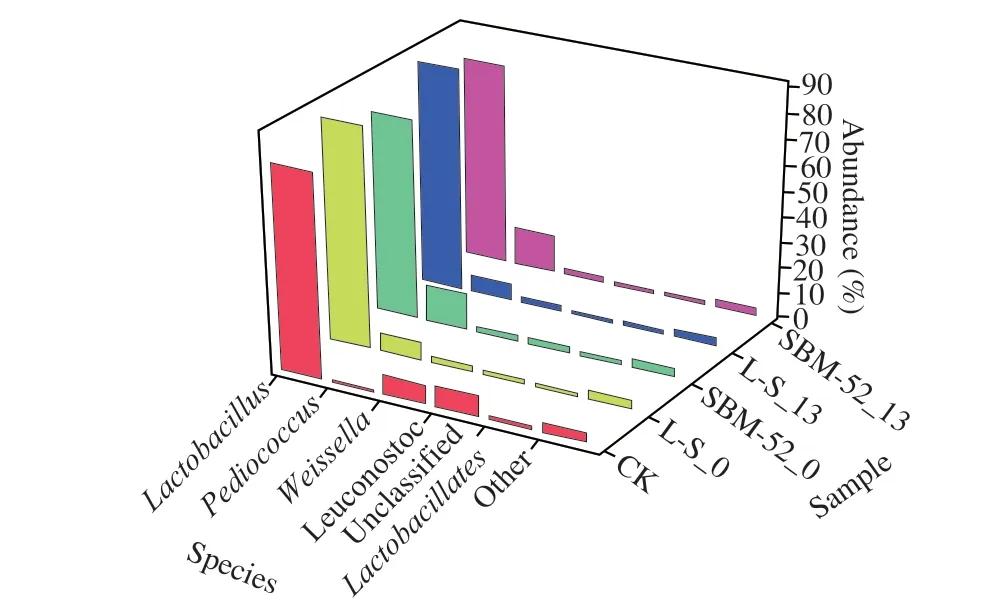
Fig. 2 3D column chart of the relative bacterial abundance at the genus level.

Table 1 Sequence abundance and microbial diversity in fermented sausages.
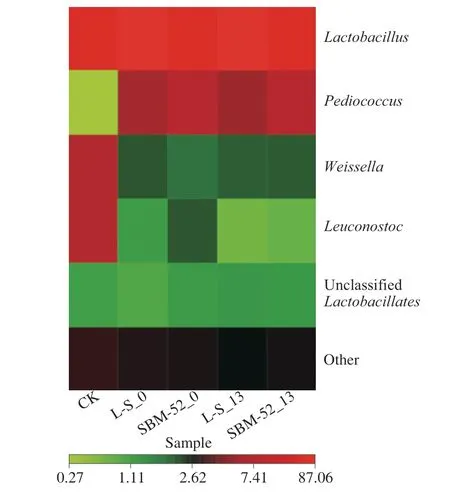
Fig. 3 Heat map analysis of bacterial community at the genus level.
The heat map analysis based on 6 different genera was used to compare the differences in microbial community structure (Fig. 3).At the genus level,Lactobacillus,Pediococcus,Weissella, andLeuconostocwere the major genera. The relative abundances ofPediococcusin the CK sample were obviously lower compared with those in the other samples and the CK sample presented the bright green signal in Fig. 3. The main sources of spoilage microorganism are environmental microorganisms.WeissellaandLeuconostocare the major spoilage microorganisms in meat [13,14]. The relative abundances ofLeuconostoc(8.04%) andWeissella(7.41%) in CK,which were presented in red color (Fig. 3), were higher than other bacteria.The relative abundances ofWeissellaandLeuconostocin the inoculated samples decreased significantly (P< 0.05). The relative abundances ofWeissellain two kinds of inoculated sausages were about 2% at the end of ripening process, whereas the abundances ofLeuconostocwere 0.71% in L-S_13 and 0.78% in SBM-52_13.The acidification caused byLactobacillusgrowth was probably responsible for this phenomenon. A lower pH suppresses the growth of some undesirable microbes and expands shelf life.
3.2.3 Integrated analysis of microbiota functional pathways
Functional prediction by Kyoto Encyclopedia of Genes and Genomes (KEGG) were annotated based on 16S sequencing data.Metabolic pathways are grouped into six categories according to level 1: metabolism, genetic information processing, environmental information processing, cellular processes, organismal systems, and human diseases. The function prediction heatmap of the subfunction of metabolic pathways was drawn according to level 2 (Fig. 4).Thirty-nine subfunctions of metabolic pathways were detected in the 5 samples, and about 48.5% genes were mapped on metabolism.Wang et al. [15] also found that metabolism is the dominant functional pathway in fermented cabbage samples. The metabolism pathway is the main pathway for the nutrition, growth, and reproduction of microorganisms. The metabolism pathway involves important processes that enhance flavor and taste [16]. The KEGG pathways showed that L-S_0, L-S_13, SBM-52_0, and SBM-52_13 have very similar pathways, including amino acid metabolism,carbohydrate metabolism, energy metabolism, nucleotide metabolism,replication and repair, membrane transport, and cellular processes and signaling. Life activities could cause substantial changes in energy generation and utilization. The predicted genes in L-S_0 and SBM-52_0 were considerably higher than those in L-S_13 and SBM-52_13.The decrease in species richness was related to decreases in pH and Aw during ripening. Single species richness could delay metabolism and transportation. The subfunctions of metabolic pathways in CK based on level 2 were significantly lower than those in the other samples. This result indicates that microbial metabolism was higher in the inoculated samples. This result is similar to that reported in a previously published study [17].
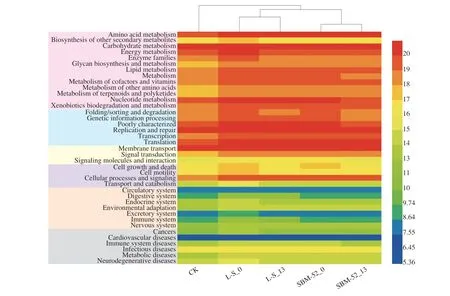
Fig. 4 KEGG function prediction heatmap of metabolic pathway.
3.3 Volatile flavor compounds
3.3.1 Composition analysis of volatile flavor compounds
The 120 volatile compounds detected in the five samples include aldehydes (20), ketones (7), alcohols (19), acids (7), esters (22),alkanes (12), alkenes (26), and others (7) as shown in Table 2. These substances were produced from lipid oxidation, protein hydrolysis,and amino acid catabolism. The ripening process of sausages could lead to the formation of many volatile compounds. We detected 60,67, 64, and 72 volatile compounds in L-S_0, L-S_13, SBM-52_0, and SBM-52_13, respectively. The result suggests that aroma components become more complicated with the extension of ripening time.
Aldehydes are typical products formed by lipid oxidation. Hexanal and nonanal are formed by lipid auto-oxidation and have lower threshold values. Hexanal and nonanal are considered the major flavor components in processed meat products [18]. Hexanal imparted grass and fat flavors are used as an index of lipid oxidation [19]. Nonanal was imparted citrus and laurel odors [20]. In the present study, the higher hexanal contents in the L-S_13 and SBM-52_13 groups than those in the L-S_0 and SBM-52_0 groups indicated that the inoculation led to a remarkable change in lipid oxidation and imparted a flavor to the sausages. The relative abundances of 2-heptenal were increased in the sausages inoculated with SBM-52 and L-S at the late stage of ripening and imparted fruity, citrus, and nut notes. 2-Octenal,which contributes a meaty flavor, was only detected in L-S_13 and SBM-52_13. Tetradecanal could provide typical orris in fermented meats, and the relative abundance of tetradecanal in L-S_13 was 4.57%.
Ketones are formed from the breakdown of alkoxy radicals and the degradation of amino acids [21]. 2-Pentadecanone was detected in all samples, and its content in the late stage of ripening was higher than in the initial stage. However, 2-pentadecanone plays an insubstantial role in the flavor and odor of fermented sausages because of its high threshold value.
Alcohols are essential for improving the flavor of sausages.Carbohydrate metabolism, lipid oxidation, and amino acid decarboxylation are considered the primary alcohol sources [22].Eucalyptol (coolness flavor), linalool (lavender flavor), and terpinen-4-ol (pepper and earthy flavor) were detected in all samples(Table 2) and contributed the rich flavor of the fermented sausages.1-Heptatriacotanol, which contributes herbal and winey flavor, was detected in L-S_13. 1-Pentanol, which contributes a mild flavor, and coniferyl alcohol, which contributes a clove flavor, were detected in SBM-52_13.
Some acids with short chains (C < 6) directly contributed to the presence of strong odors and low threshold value, which had great implications on the final fermented sausages. Acids with medium chains (C6-C12) and long chains (C14-C18) came from the hydrolyses of triglycerides and phospholipids [18]. In this study, acetic acid was only detected in L-S_13 (0.14%) and SBM-52_13 (0.47%). Acetic acid belonged to short-chain acids and has a pungent odor. Sugar metabolism was switched from homofermentative to heterofermentative because ofLactobacillusconversion of pyruvate to acetic acid, which is catalyzed by pyruvate-metabolizing enzymes [23].
Ester with its characteristic fruity and floral-like notes and low detection threshold contributed considerably to the quality of the sausages [24]. Esters are formed through the esterification of acids and alcohols by microbial esterase [25]. Twelve esters were detected in L-S_0, and their relative abundance was 4.87%. Thirteen esters were detected in L-S_13, and their relative abundance was 6.31% (Table 2).SBM-52_13 had four more kinds of esters than SBM-52_0, and the relative abundance of esters in SBM-52_13 was 2.45% higher than that in SBM-52_0. The species and relative abundances of esters at day 13 were higher than at day 0 in ripening process probably because of the high amounts of acetic acids andStaphylococcus. The microbial esterase activity ofStaphylococcuswas high. The existence of microbial esterase and acetic acid promotes the synthesis of esters [19].The fermented sausages (L-S and SBM-52) at day 13 of ripening had a characteristic lemon and lavender flavor because of their high terpinyl acetate contents.
All four inoculated samples had caryophyllene, bicyclo-hept-2-ene, farnesene,α-bisabolene, anethole, methyleugenol, myristicin,curcumene, elemicin, and limonene. The main sources of volatile flavor compounds are condiments [26]. The relative abundances of anethole in all samples were up to 50%. The content of anethole at day 13 of ripening was higher than at day 0 days probably because of the strong volatility of anethole.
3.3.2 PCA of volatile flavor compounds
PCA was used to analyze the important volatile compounds with a relative abundance of > 0.25%. The principal components with eigenvalue > 1 were retained. The eigenvalues and cumulative contribution rates of the principal components are shown in Table 3.Principal components 1 (42.8%) and 2 (31.3%), which reflected the changes in flavor compounds and the samples’ distribution, were used to chart a biplot figure (Fig. 5).
The four inoculated samples are shown in the four quadrants of the plots in Fig. 5. L-S_0, SBM-52_13, SBM-52_0, and L-S_13 are distributed in the first, second, third, and fourth quadrant, respectively.The four samples are clearly separated, which indicates that they had remarkable differences in flavor after inoculated with starters. The conversion of substances became more frequent with the prolongation of time. The kinds and contents of predominant volatile compounds remarkably changed in SBM-52 and L-S after 13 days of ripening.
The component score coefficients of the four fermented sausages are presented in Fig. 6. The five compounds that contributed greatly to the qualities of L-S_0 sausages (score > 1.0, Fig. 6A) with turpentine odor, floral scent and special odor. The six compounds with the highest scores in SBM-52_0 sausages (Fig. 6B) included eugenol and anethole, which have dianthus and fennel flavors. Eleven volatile compounds were found in L-S_13, and the major volatile compounds that contributed to flavor development included 2-nonenal (fatty and green flavor), tetradecanal (fatty and orris flavor), ethylstearate (waxy),and terpinyl acetate (lemon and lavender flavor). Volatile compounds with similar structures or flavor often have synergistic interactions [27].The 3D structures of 2-nonenal and tetradecanal are shown in Fig. 7A–B, respectively. These compounds have very similar structures and are acyclic aliphatic aldehydes [28,29]. The structure of ethylstearate (Fig. 7C) has straight-chain esters, whereas terpinyl acetate contains a benzene ring (Fig. 7D). 2-nonenal, tetradecanal,ethylstearate, and terpinyl acetate affected the formation of flavor, and 2-nonenal, tetradecanal had synergistic interactions in the L-S samples at the end of ripening. Twenty-one compounds had high scores in SBM-52_13 (Fig. 6D), and the characteristic flavor compounds were hexanal (fatty and green flavor), 2-heptenal (fatty, citrus and nutty flavor), 2-octenal (fatty and meat flavor), 2-undecenal (fresh aldehydic),and isoeugenol (dianthus and burnt sugar flavor). The 3D structures of four aldehydes are acyclic aliphatic aldehydes (Figs. 7E–F), whereas isoeugenol is phenol. The SBM-52 sausages were affected by these five substances, and aldehydes cooperate with each other.
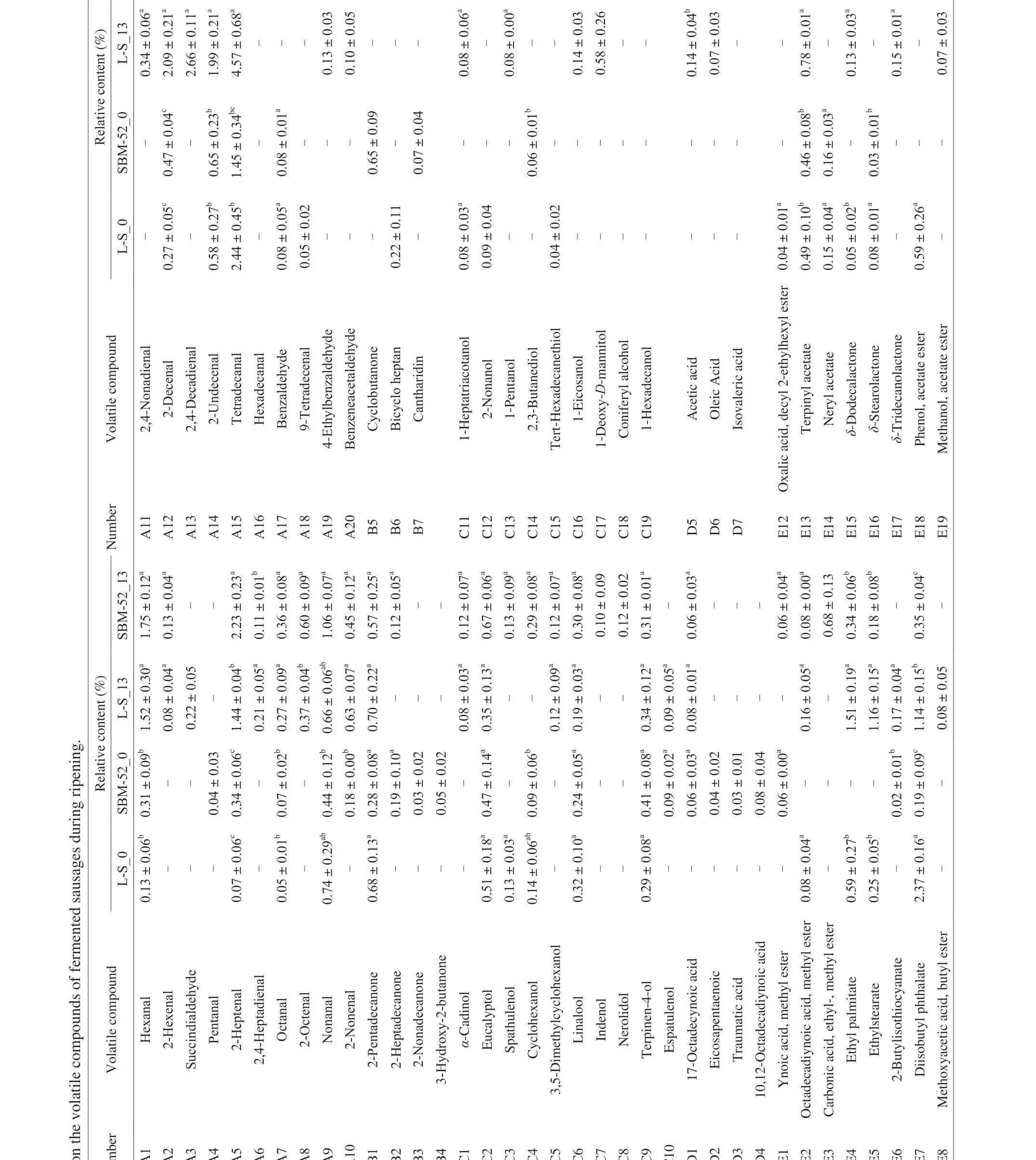
Table 2 Effect of starters on the volatile compounds of fermented sausages during ripening.
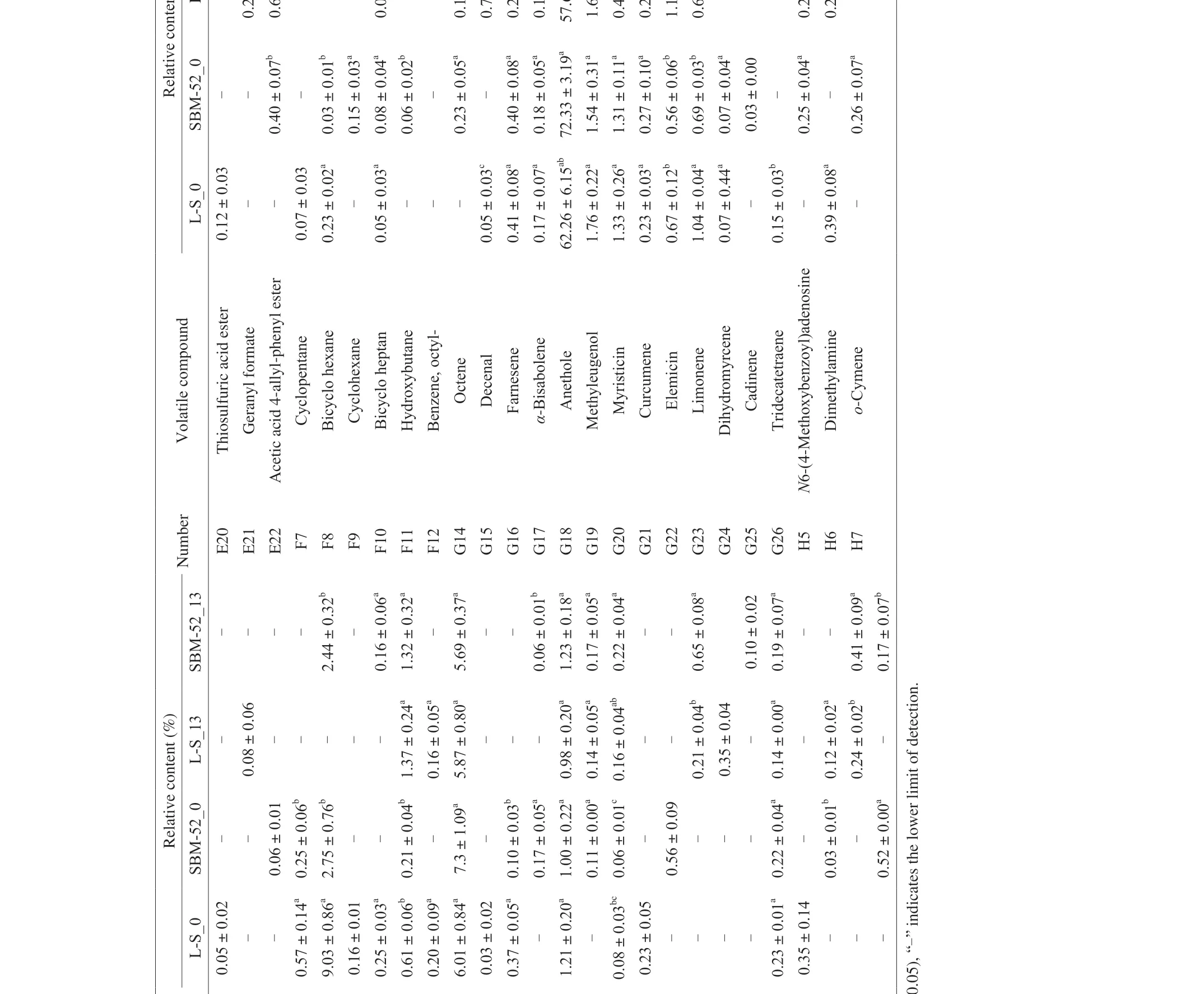
Table 2 (Continued)

Table 3 Principal components of fermented sausages.
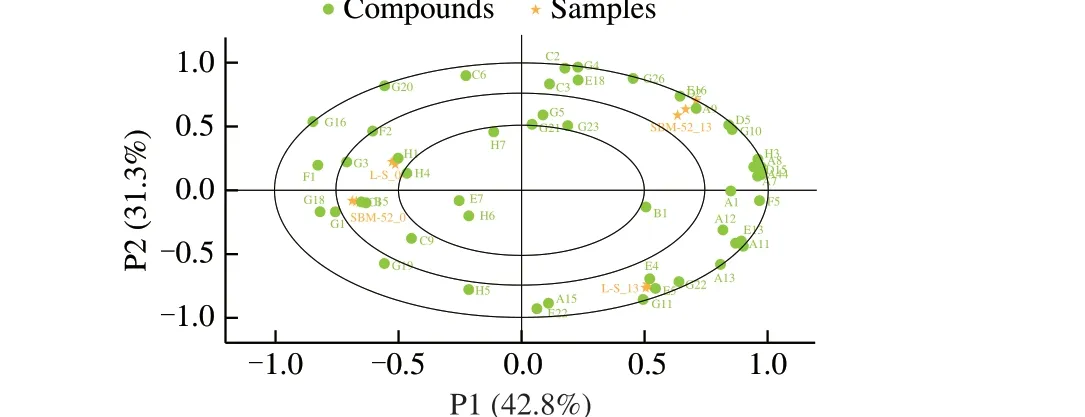
Fig. 5 Biplot of main volatile flavor compounds in fermented sausage.
3.4 Sensory evaluation
Sensory evaluation is crucial to determine the acceptability of products. This study assessed the sensory qualities of fermented sausages based on a 9-point hedonic scale. The median scores of the sensorial characteristics of fermented sausages at the end of the ripening stage are presented in Fig. 8. Small differences were observed in the sensory qualities between the L-S and SBM-52 samples. The L-S samples had higher scores in aroma odor, acid odor,and overall odor assessment than the SBM-52 samples; thus, the L-S samples had a higher total assessment score at the end of the ripening process (P< 0.05). The results demonstrated that the sausages inoculated with L-S had excellent sensory qualities. Therefore, L-S could be used in manufacturing fermented sausage.
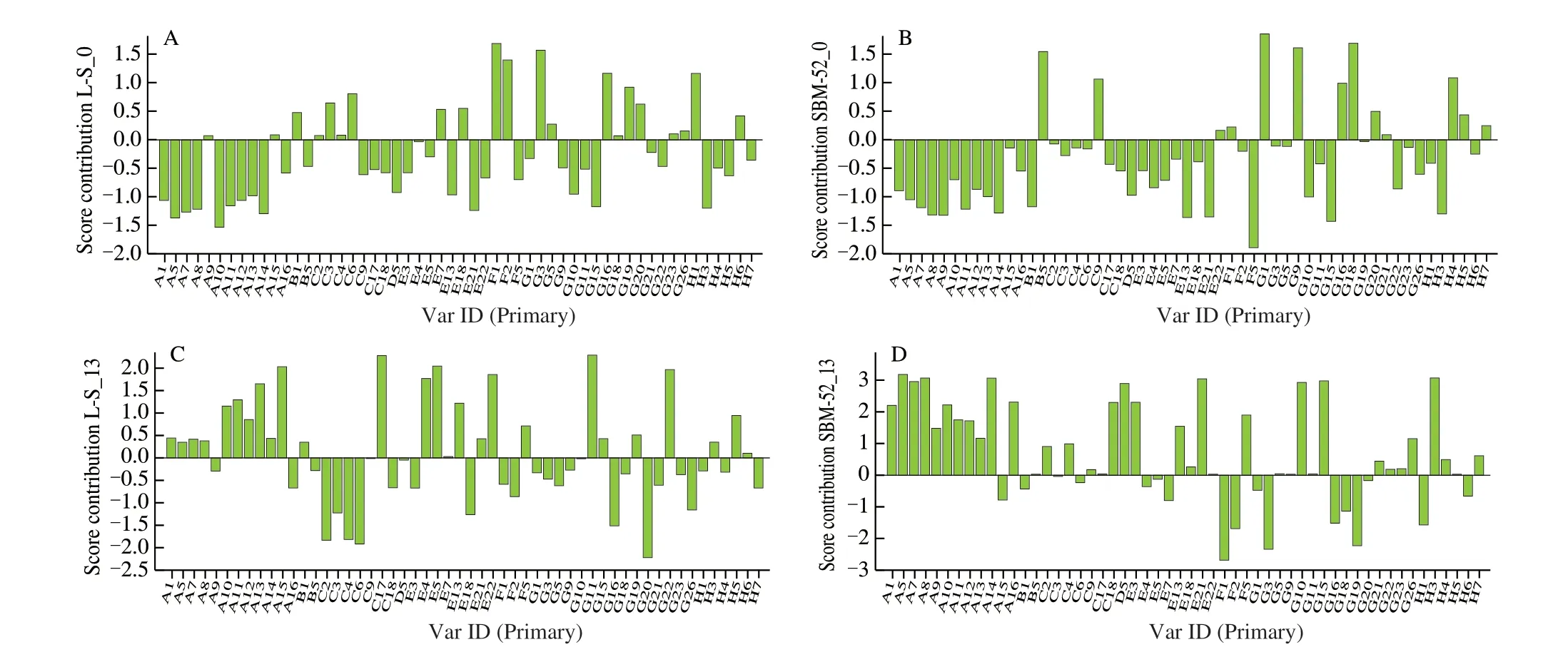
Fig. 6 Graphical distribution of PCA scores for individual samples: (A), L-S_0; (B), SBM-52_0; (C), L-S_13; (D), SBM-52_13.

Fig. 7 3D structures of the main volatile flavor compounds: (A), 2-nonenal; (B), tetradecanal; (C), ethylstearate; (D), terpinyl acetate; (E), hexanal; (F), 2-heptenal;(G), 2-octenal; (H), 2-undecenal; (I), isoeugenol.
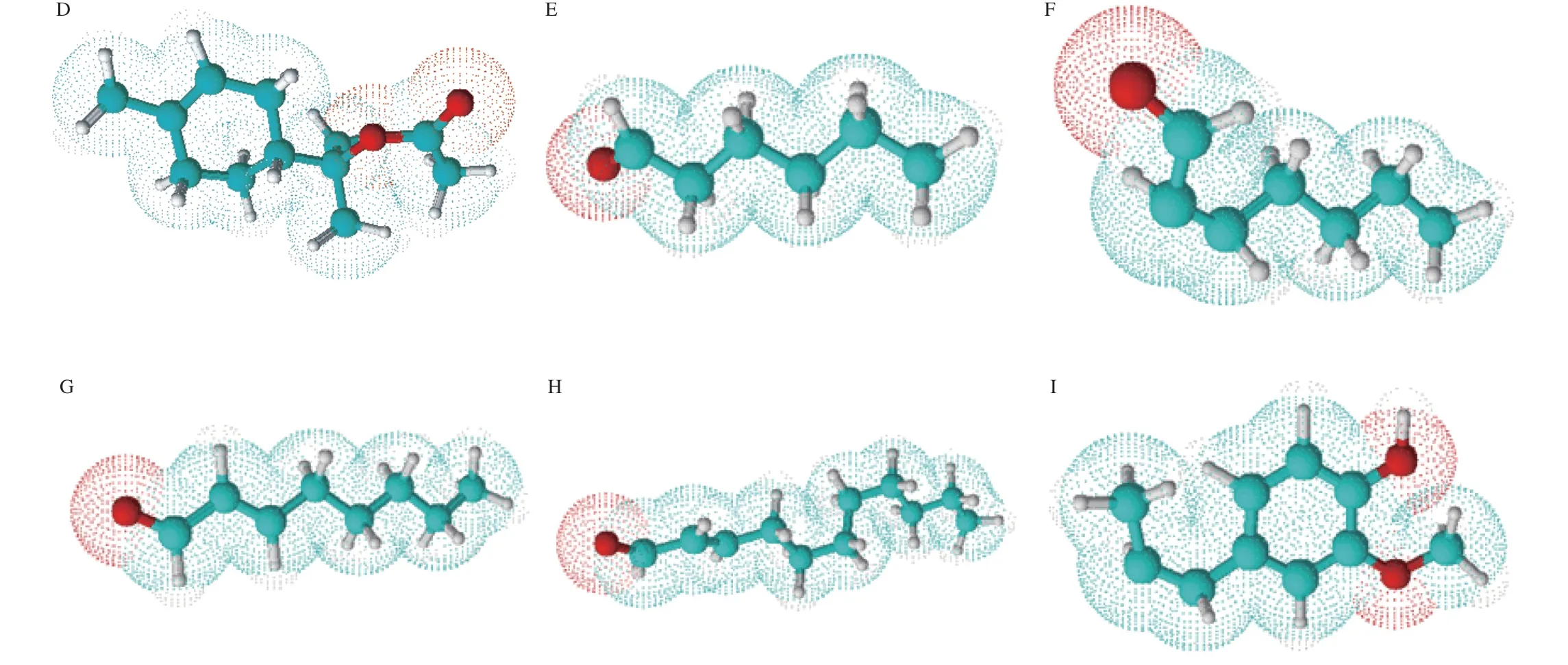
Fig. 7 (Continued)
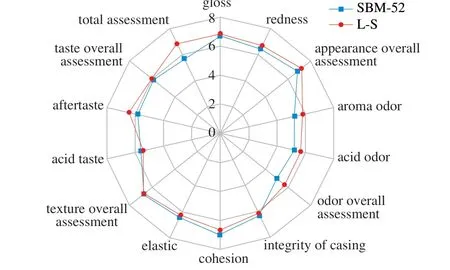
Fig. 8 Sensory evaluation of fermented sausages at the end of the ripening stage.
4. Discussion
Culture-dependent and culture-independent methods were employed to evaluate the changes in bacterial communities during the ripening of the fermented sausages.Lactobacillus,L. lactis,andStaphylococcuscounts at the end of ripening were significantly lower than at day 0 days (P< 0.05). The decrease in bacterial counts might be due to the carbohydrate consumption during the growth ofLactobacillusand the transformation of protein and carbohydrate [30].In the process of transformation, protein and carbohydrate are degraded to acids and alcohols, which leads to the decrease in pH. A lower pH inhibits the growth of spoilage bacteria, such asLactobacillus,L. lactis,andStaphylococcus. The gradual decrease in Aw during the ripening of the fermented sausages increased the NaCl concentration. The growth of some bacterial strains is inhibited by high NaCl concentration [31]. The content ofStaphylococcuswas lower than those ofLactobacillusandL. lactisduring the ripening process, becauseStaphylococcusis sensitive to environments with low pH [32].
Specific spoilage organisms, which could cause meat spoilage, are dominant in meat products [33].WeissellaandLeuconostocare the predominant spoilage microorganisms in fresh sausages [34,35]. Our study had the same result. The relative abundances ofLeuconostocandWeissella, which could go against the fermentation and ripening processes, were high in CK (8.04% and 7.41%, respectively). The relative abundances ofLeuconostocandWeissellain fermented sausages decreased to the minimum level of 2.1%. This finding suggests that the inoculated starters can be used to extend shelf life.
Many metabolic pathways might contribute to the special flavor formation of fermented sausages. The central metabolic pathways of carbohydrate are the tricarboxylic acid cycle, glycolysis, pentose phosphate pathway, pyruvate metabolism, and citric acid cycle [36,37].Lactic acid, citric acid, and malic acid are generated to decrease the pH [38]. The metabolic pathways generated a sour characteristic and inhibited the growth of pathogenic and spoilage bacteria. Sugar heterofermentative could produce acetoin and 2-butanone, which are interrelated and essential for aroma development [39]. Transamination reaction is the main approach of flavor formation by amino acid metabolism.α-Ketoacid could be produced from amino acid by the action of transaminase and then converted into aldehyde and esters under catalysis by decarboxylase [40]. Acetaldehyde, 2-butanone,alanine, and ethyl lactate are generated through aromatic amino acid catabolism, whereas aldehydes, ketones, alcohols, hydrocarbons,and free amino acids are generated through lipid metabolism. These compounds are flavor substrates [41].
The main flavor sources of fermented foods are the metabolic activity of bacterial strains and abiotic environmental factors. Abiotic environmental factors, such as temperature, humidity, and pH,indirectly affect flavor by affecting microbial activities, structure,and interaction. The flavor of SBM-52 samples was associated with aldehydes (hexanal, 2-heptenal, 2-octenal and 2-undecenal), and alkenes (isoeugenol), whereas that of L-S was caused by aldehydes(2-nonenal, tetradecanal) and esters (ethylstearate and terpinyl acetate)at the end of ripening. The compounds present in L-S and SBM-52 samples were different owing to the different starters.L. plantarumwas predominant in L-S. The conversion of organic acid to aldehydes,ethers, and esters is responsible for specific aroma notes during the catabolism of pyruvate and lactic acid based onL. plantarum[42].The relative abundances ofStaphylococcuswere high in L-S and SBM-52.Staphylococcushas high lipase and protease activities and could generate flavor precursors, such as free amino acids, free fatty acids, and polypeptide, which contribute to flavor formation [43]. Not all strains had a positive effect on the flavor of fermented sausages.By contrast, the overgrowth of spoilage organisms resulted in the development of off-flavors in meat products.Weissellacould cause changes in the texture and development of slime and off-odor. H2O2produced byWeissellaalso causes changes in color and taste [44].Leuconostocaccelerates the accumulation of peculiar smell produced by acetoin, diacetyl, butanediol, hexanal, and heptanal and produces a rancid butter flavor [45].
In conclusion, aroma development in meat products is a complex process produced by the interactions of many factors. Various microorganisms are involved in the formation of aromatic compounds through different metabolic pathways. An in-depth understanding of the dynamics of microbial communities might help reveal bacterial community composition, metabolic activities, and flavor development.Thus, inoculating starters is likely to have important impacts on the industrial production of fermented sausages.
5. Conclusion
The bacterial diversity in the fermented sausages was analyzed by culture-dependent (colony count) and culture-independent (highthroughput sequencing) methods. The major volatile compounds were explored based on GC-MS and PCA. The results showed that fermented sausages inoculated with commercial SBM-52 starter and mixed L-S starter cultures had high relative abundances ofLactobacillusandPediococcus. The L-S-inoculated group had higherLactobacilluscounts andL. lactiscounts than the SBM-52-inoculated group. The abilities of L-S starter to inhibit growth ofLeuconostocandWeissellawere equivalent to the commercial SBM-52starter.L-S group and SBM-52 group had very similar functional pathways,including amino acid metabolism, carbohydrate metabolism,energy metabolism. The flavor of the L-S fermented sausages was considerably different from that of SBM-52 fermented sausages. The relative contents of 2-nonenal, tetradecanal, ethylstearate and terpinyl acetate were high and contributed to fatty, green, orris, waxy, lemon and lavender flavor in L-S group. The sausages inoculated with L-S had excellent sensory qualities as determined by evaluators.
Conflict of interest
The authors declare no conflict of interest.
Acknowledgement
This research was supported by the Natural Science Research Projects of Shanxi Province (20210302123400) in China, Agricultural Valley Construction Research Project of Shanxi Province(SXNGJSKYZX201903) and Key Science and Technology Programs in Agriculture of Shanxi Province (201903D211008). The authors thank the Animal Products Laboratory of Shanxi Agricultural University for the determination and analysis of indicators.
杂志排行
食品科学与人类健康(英文)的其它文章
- Evaluation and selection of yeasts as potential aroma enhancers for the production of dry-cured ham
- Preserved egg white alleviates DSS-induced colitis in mice through the reduction of oxidative stress, modulation of inf lammatory cytokines,NF-κB, MAPK and gut microbiota composition
- Energy status regulated umami compound metabolism in harvested shiitake mushrooms (Lentinus edodes) with spores triggered to release
- Edible mushrooms as a potent therapeutics of subclinical thyroid dysfunction among adults, especially in obese individuals: a prospective cohort study
- Screening hepatoprotective effective components of Lonicerae japonica Flos based on the spectrum-effect relationship and its mechanism exploring
- Effects of the degree of oral processing on the properties of saliva-participating emulsions: using stewed pork with brown sauce as the model
